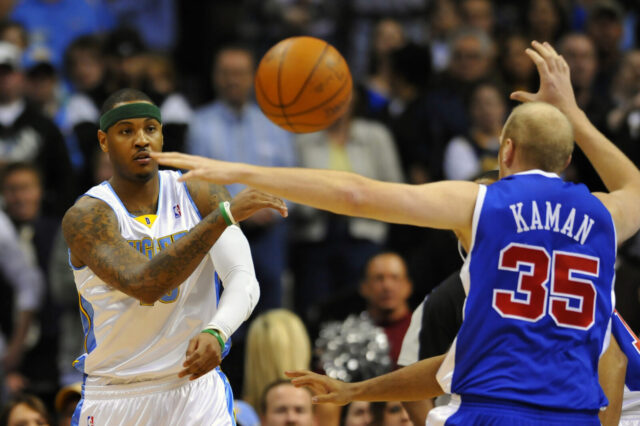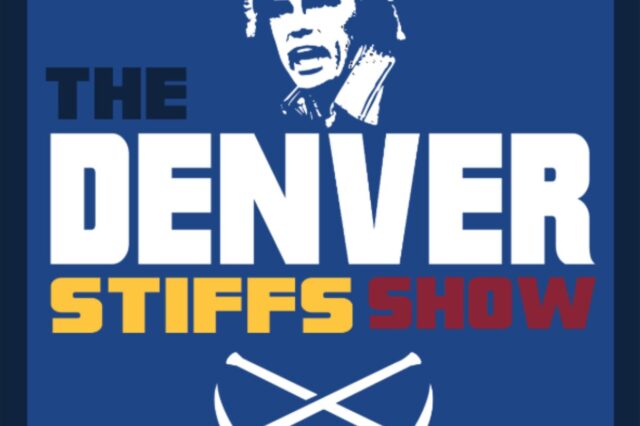The Denver Nuggets have a defense problem. After looking like an improved-yet-still-average defense before Paul Millsap’s injury on November 19th, the team has fallen to 23rd in defensive rating since November 20th. The recent 122 points allowed by the Dallas Mavericks on Monday marked a low point in the season for Denver’s defense and there was plenty in the tape from that game that looked all too familiar to Denver Nuggets fans that followed the team closely last year. Most notably, perimeter defense.
The Mavericks employ lots of crafty and quick guards to unravel Denver’s porous perimeter defense and expose one of Denver’s biggest weaknesses. Let’s take a closer look at the damage in this week’s spotlight.
This content is no longer available.
Stopping the ball in transition
The first thing that was off about the Nuggets last night was their inability to stop the ball in transition. Dallas has four very speedy guards in J.J. Barea, Yogi Ferrell, Dennis Smith Jr. and Devin Harris. All four of those guys did a great job of attacking the Nuggets in transition and were able to get 24 transition points out of it. But transition points only tell half of the story. Since Denver’s guards did such a poor job of stopping the ball in the open court, Denver’s defense started a lot of defensive possessions in mismatches and/or scrambled from the jump.
Blow-bys
The team also struggled with simple blowbys on the perimeter. In the clip below, Wilson Chandler gets blown by from the top of the key when matched up with the speedier Smith Jr. The blowby alone is bad but this clip is also a great example of the difference defensively between Kenneth Faried and Paul Millsap. Millsap is elite at providing early help, especially when his man is out of position to score. In this clip, Faried gets caught flat footed guarding Salah Mejri who isn’t a threat in that short corner spot. Faried should be able to anticipate this drive the moment Smith Jr. waves off the screen. Instead, he takes the play off and doesn’t even stunt at Smith Jr. as he drives.
Trey Lyles also struggles with perimeter containment. His footwork looks pretty unnatural out on the perimeter, shading Harrison Barnes to his strong hand before foolishly reaching while flying out of bounds. Lyles doesn’t have great hands on defense, foot speed to gamble for steals, or hops to chase blocks. What he does have is length and strength. That’s not a great recipe for highlight plays but it can be a great recipe for solid, contain defense. Just forcing Barnes into a contest 7-foot jump shot would be considered a win. Instead Lyles gets beat and then turns it into a 3-point play with the silly foul.
Lyles has also struggled with how to play in-between on pick and rolls or when providing help on drives. It’s sort of a game of chicken for bigs when trying to help on drives and screens. Provide too much help and the guard will throw the lob. Provide no help and you look like Faried in the clip above, allowing an easy drive to the rim. Lyles struggled with this skill against Dallas in his short stint as a smallball center.
Lyles wasn’t the only Nuggets player that struggled on defense against Dallas but unfortunately for him, his clips did provide the best examples of some of the things a lot of wings on the roster struggled with, including closeouts. Here, he runs the defender off of the line which is the first task on a closeout but he is so slow to recover that the ball handler is able to get all the way to the rim at full speed forcing the Nuggets to rotate and open up a three-point shooter in the corner.
That is how the Dallas Mavericks, a team that ranked 26th in offensive efficiency coming into the game, scored 122 points. It’s also how a team that averages just 37.8 points in the paint – good for 29th most in the NBA – scored 64 such points against Denver.
The Nuggets defensive issues last season and the last few weeks this season had many culprits but the biggest culprit was perimeter containment. Until the team improves in that department, they’ll continue to place a very low ceiling on how good of a defensive team they can be.
This content is no longer available.
Last week I wrote about ways to disguise Plumlee pick and rolls to help distract the defense. One action I really like is when they use a wing, usually Gary Harris, as a decoy ball screener before running Plumlee right behind to set the actual screen. In the two examples below, the Nuggets run a ram screen (the term used to describe a down screen for a screener) that ultimately leads to a Plumlee ball screen. In the first example, they get an open dunk. On the second example, Mudiay takes the pull up jumper but he also had Will Barton in the corner if he wanted.
Nikola Jokic is taking just 17% of his FGA’s at the rim, down from 34% last season. He’s also taking fewer of those floater shots from just outside of the restricted area, an area of the court that he was incredibly efficient from last season. His assists are also down a bit and he’s fallen from the 85th percentile in efficiency on rolls to the rim last season, to the 31st percentile this season according to Synergy.
One reason for the drop off is that the Nuggets were having him pop a lot more this season, perhaps in an effort to space the floor with Paul Millsap manning the short corner. But perhaps another reason for the dropoff is that the Nuggets guards have had a hard time getting him the ball when defenses trap the ball handler. Jamal Murray has been the worst offender. In the clip below, watch how Jokic is calling for the ball on the roll but the guards are unable to get it to him, generating turnovers when they try to force it to Jokic and when they try to kickout to the opposite side.
This skill is essential to unlocking Denver’s high-powered offense from last season. Both Jokic and Mason Plumlee are great at making the right read when they can get a 3-on-2 or 4-on-3 situation. High efficiency shots are all but automatic when a team plays the pick and roll that aggressively.
I loved this ATO (after timeout play) by the Mavericks. The play forces JJ Barea’s defender to fight through two screens (known as an “Iverson cut” since Allen Iverson made this base action famous) only to have to turn around and fight right back through those sames screens as double high ball screens going the other direction. Only instead of running the second part of the action, the Mavericks use it as a decoy to reverse the ball and attack one on one. Mudiay would usually expect some type of help side behind him on this play but since Trey Lyles is focused on what he assumed would be a double high screen, he is out of position to help.
This content is no longer available.
Will Barton | CHI @ DEN | Career-high 37 points, 13-19 FG, 6-9 3FG, game winner
“There’s Will Barton, and there’s ‘Thrill’ Barton,” according to Michael Malone. Last Thursday against the Chicago Bulls, Thrill Barton showed up in a big way, right when Denver needed him the most. The Nuggets inexplicably got off to an awful start against the lowly Bulls and needed a career-high performance from Thrill and a game-winning, body-twisting layup. It was a special night for Willie B. Buckets, aka Thrill, aka the People’s Champ.
Jamal Murray | LAL @ DEN | 28 points, 4 rebounds, 4 assists
The Blue Arrow took his matchup with Lonzo Ball very personally, going after him from tipoff until the final seconds of the game when he took an opportunity to rub it in Lonzo’s face that the Nuggets were going to get the win. Murray might take a hit for sportsmanship but he displayed a much needed edge for the Denver Nuggets and showed that he’s the type of guy that gets better when there’s a little something extra at stake.
Will Barton | DEN @ DAL | 23 points, 8 rebounds, 6 assists
Barton wasn’t great in this game but neither was anyone else on the Nuggets roster. The road Nuggets continue to look like the worst team in the league. This is the 5th or 6th game ball that has gone to someone who had an average or below average game but managed to put up the best stat line because even in a blowout loss, someone has to score points, grab rebounds, and run out the clock until the game is over.
Previous editions of Pickaxe and O’s


